The Use of Social Media: Is it an Addiction? A Comprehensive Report
VerifiedAdded on 2023/06/03
|15
|3029
|208
Report
AI Summary
This report investigates the use of social media platforms and whether their usage can be classified as an addiction. The study involved a survey of 50 participants of varying ages to determine the frequency and purpose of their social media use. The research explores the motivations behind social media use, including personal interaction, work-related activities, and the desire for validation. The report analyzes the survey data to identify correlations between age, social media usage, and perceptions of addiction, also examining the behavioral traits associated with social media use. The findings suggest that while social media offers various benefits, such as communication and marketing, it also raises concerns about potential addictive behaviors, especially among younger users. The conclusion indicates that the addictive nature of social media is complex and multifaceted, with recommendations for future research focusing on more in-depth analysis of the psychological and behavioral aspects of social media use. The report is a contribution to Desklib, a platform providing AI-based study tools for students.
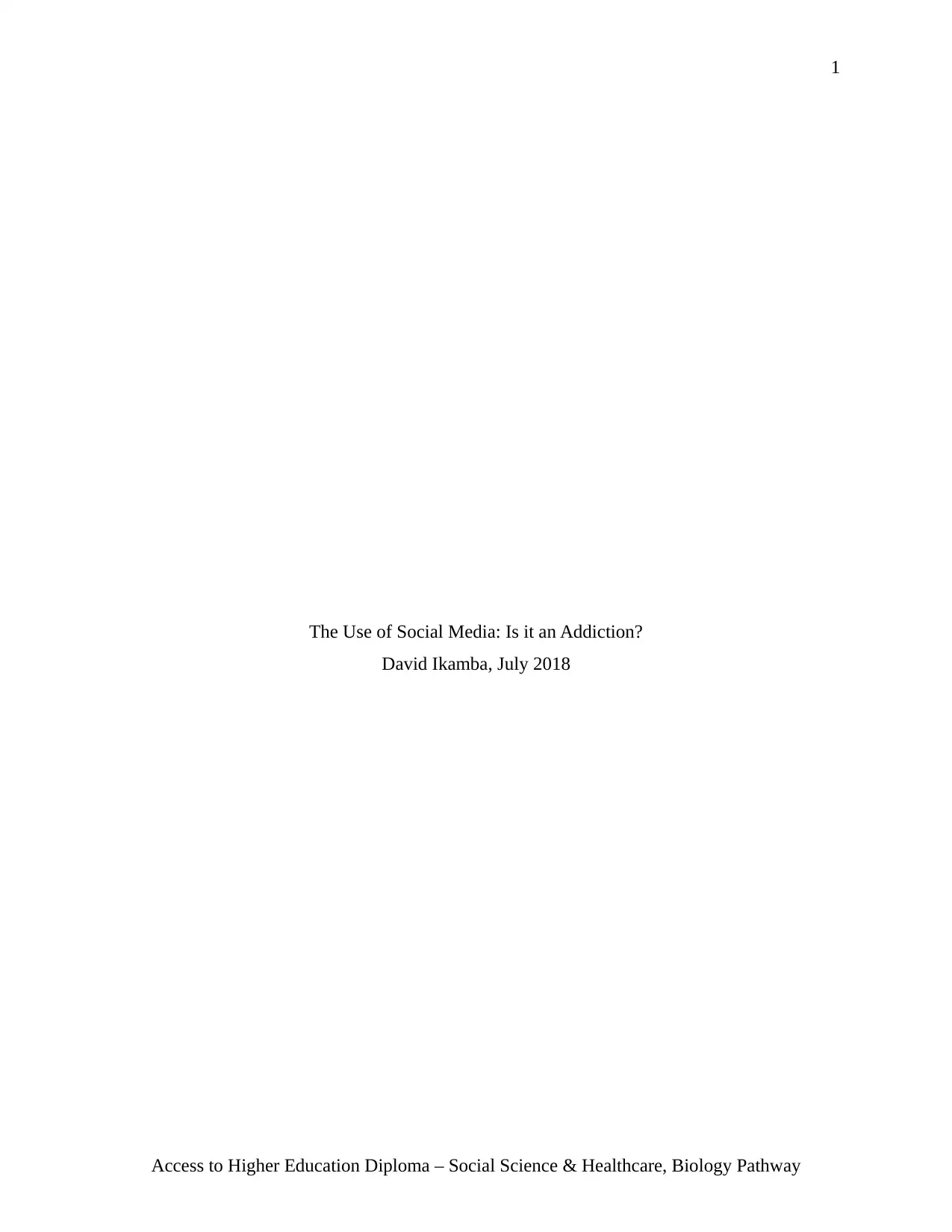
1
The Use of Social Media: Is it an Addiction?
David Ikamba, July 2018
Access to Higher Education Diploma – Social Science & Healthcare, Biology Pathway
The Use of Social Media: Is it an Addiction?
David Ikamba, July 2018
Access to Higher Education Diploma – Social Science & Healthcare, Biology Pathway
Paraphrase This Document
Need a fresh take? Get an instant paraphrase of this document with our AI Paraphraser
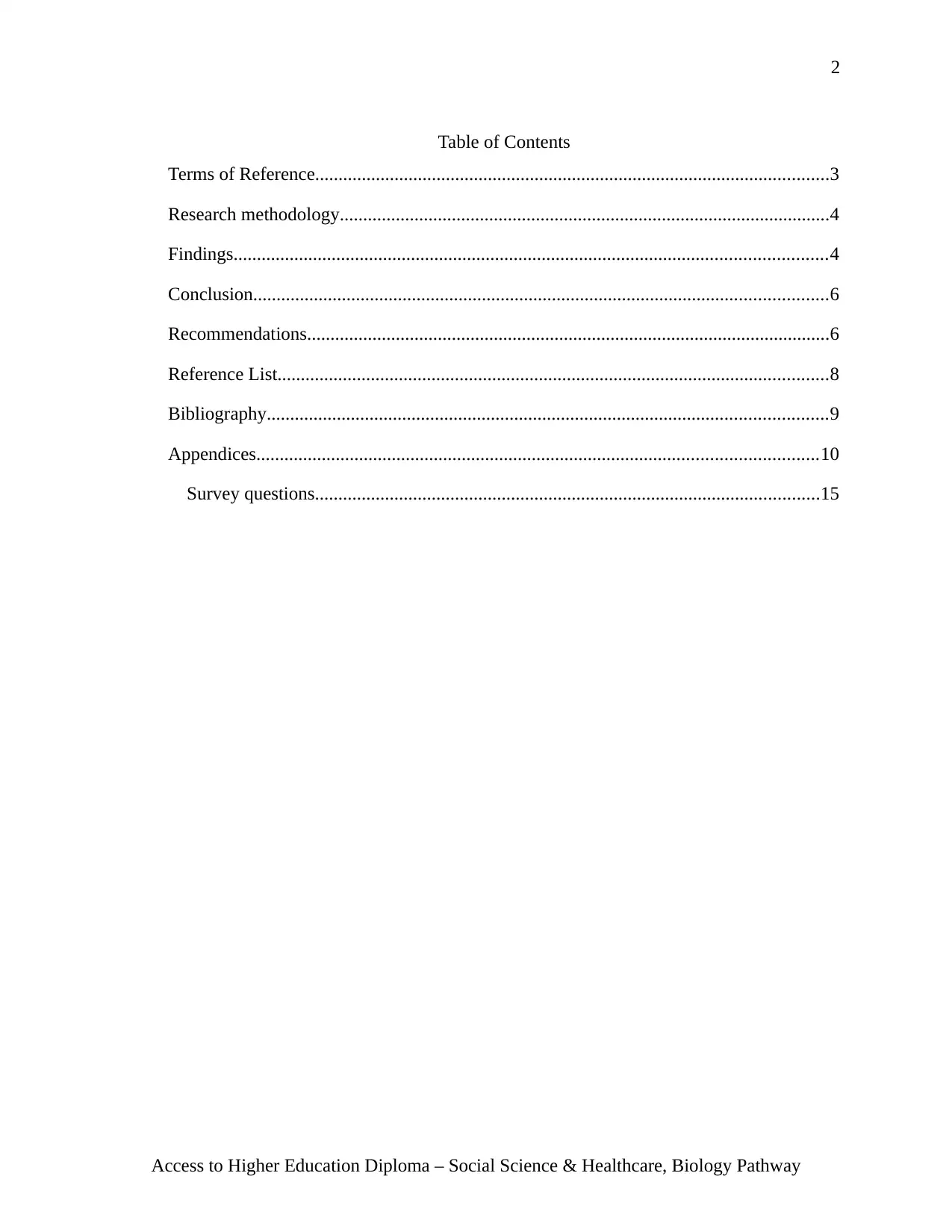
2
Table of Contents
Terms of Reference..............................................................................................................3
Research methodology.........................................................................................................4
Findings...............................................................................................................................4
Conclusion...........................................................................................................................6
Recommendations................................................................................................................6
Reference List......................................................................................................................8
Bibliography........................................................................................................................9
Appendices........................................................................................................................10
Survey questions............................................................................................................15
Access to Higher Education Diploma – Social Science & Healthcare, Biology Pathway
Table of Contents
Terms of Reference..............................................................................................................3
Research methodology.........................................................................................................4
Findings...............................................................................................................................4
Conclusion...........................................................................................................................6
Recommendations................................................................................................................6
Reference List......................................................................................................................8
Bibliography........................................................................................................................9
Appendices........................................................................................................................10
Survey questions............................................................................................................15
Access to Higher Education Diploma – Social Science & Healthcare, Biology Pathway
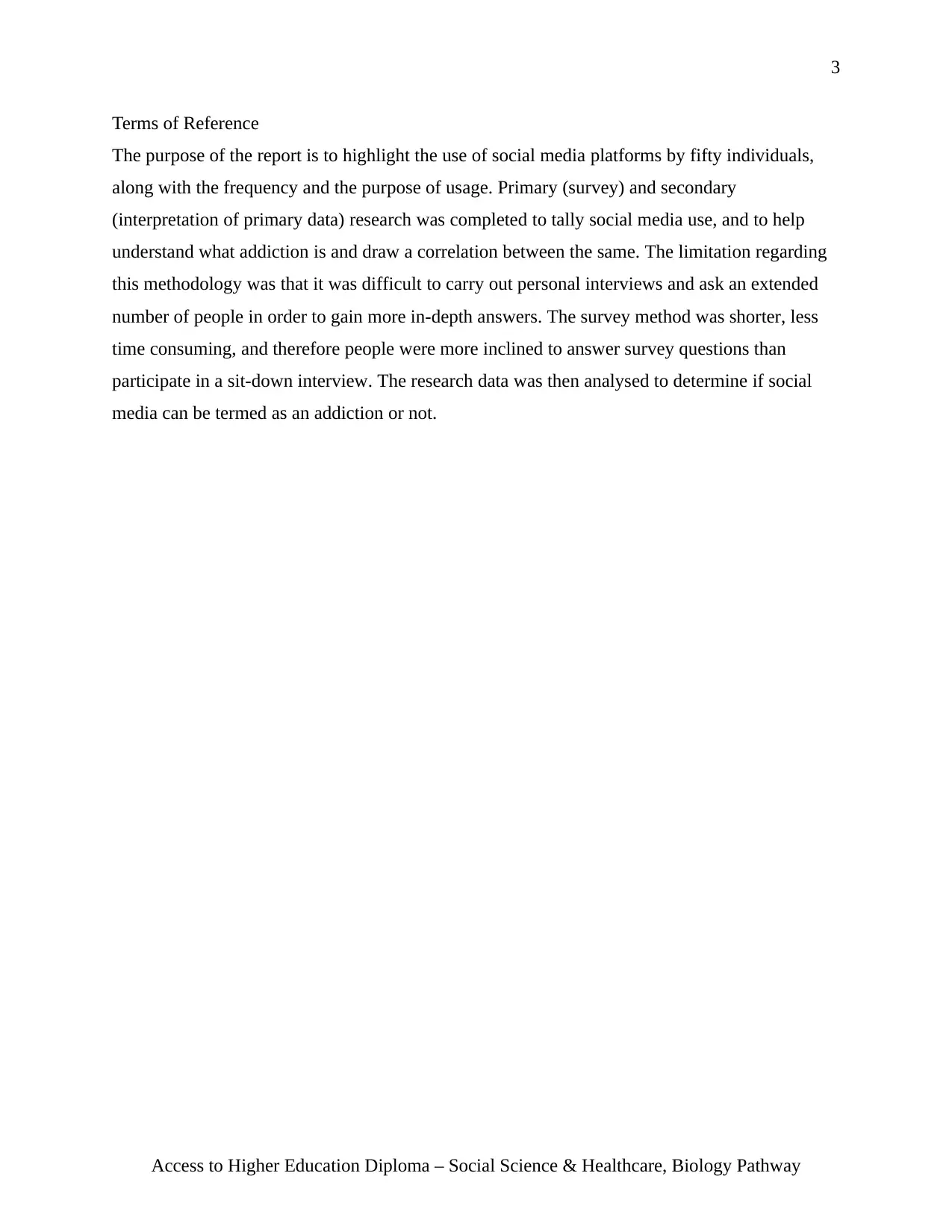
3
Terms of Reference
The purpose of the report is to highlight the use of social media platforms by fifty individuals,
along with the frequency and the purpose of usage. Primary (survey) and secondary
(interpretation of primary data) research was completed to tally social media use, and to help
understand what addiction is and draw a correlation between the same. The limitation regarding
this methodology was that it was difficult to carry out personal interviews and ask an extended
number of people in order to gain more in-depth answers. The survey method was shorter, less
time consuming, and therefore people were more inclined to answer survey questions than
participate in a sit-down interview. The research data was then analysed to determine if social
media can be termed as an addiction or not.
Access to Higher Education Diploma – Social Science & Healthcare, Biology Pathway
Terms of Reference
The purpose of the report is to highlight the use of social media platforms by fifty individuals,
along with the frequency and the purpose of usage. Primary (survey) and secondary
(interpretation of primary data) research was completed to tally social media use, and to help
understand what addiction is and draw a correlation between the same. The limitation regarding
this methodology was that it was difficult to carry out personal interviews and ask an extended
number of people in order to gain more in-depth answers. The survey method was shorter, less
time consuming, and therefore people were more inclined to answer survey questions than
participate in a sit-down interview. The research data was then analysed to determine if social
media can be termed as an addiction or not.
Access to Higher Education Diploma – Social Science & Healthcare, Biology Pathway
⊘ This is a preview!⊘
Do you want full access?
Subscribe today to unlock all pages.

Trusted by 1+ million students worldwide
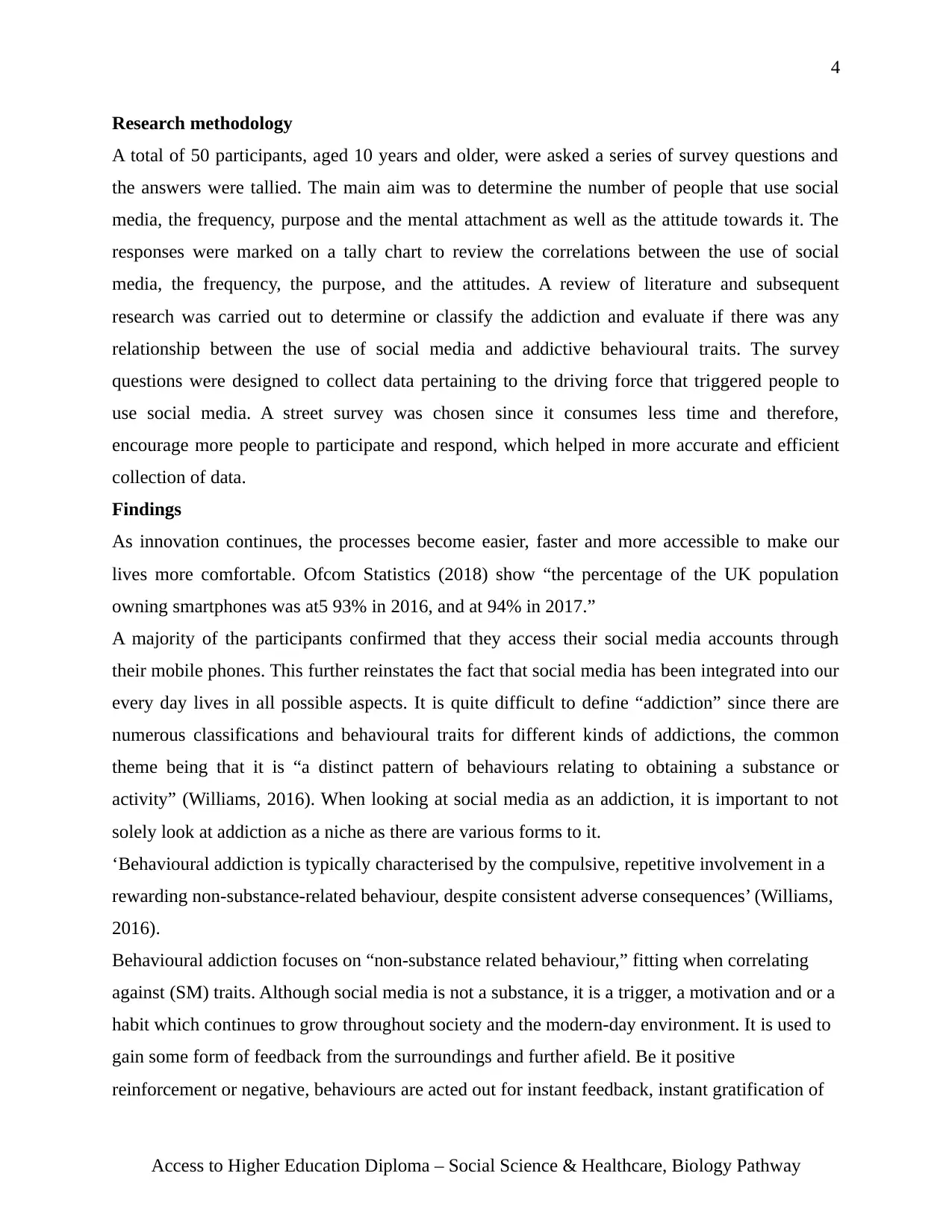
4
Research methodology
A total of 50 participants, aged 10 years and older, were asked a series of survey questions and
the answers were tallied. The main aim was to determine the number of people that use social
media, the frequency, purpose and the mental attachment as well as the attitude towards it. The
responses were marked on a tally chart to review the correlations between the use of social
media, the frequency, the purpose, and the attitudes. A review of literature and subsequent
research was carried out to determine or classify the addiction and evaluate if there was any
relationship between the use of social media and addictive behavioural traits. The survey
questions were designed to collect data pertaining to the driving force that triggered people to
use social media. A street survey was chosen since it consumes less time and therefore,
encourage more people to participate and respond, which helped in more accurate and efficient
collection of data.
Findings
As innovation continues, the processes become easier, faster and more accessible to make our
lives more comfortable. Ofcom Statistics (2018) show “the percentage of the UK population
owning smartphones was at5 93% in 2016, and at 94% in 2017.”
A majority of the participants confirmed that they access their social media accounts through
their mobile phones. This further reinstates the fact that social media has been integrated into our
every day lives in all possible aspects. It is quite difficult to define “addiction” since there are
numerous classifications and behavioural traits for different kinds of addictions, the common
theme being that it is “a distinct pattern of behaviours relating to obtaining a substance or
activity” (Williams, 2016). When looking at social media as an addiction, it is important to not
solely look at addiction as a niche as there are various forms to it.
‘Behavioural addiction is typically characterised by the compulsive, repetitive involvement in a
rewarding non-substance-related behaviour, despite consistent adverse consequences’ (Williams,
2016).
Behavioural addiction focuses on “non-substance related behaviour,” fitting when correlating
against (SM) traits. Although social media is not a substance, it is a trigger, a motivation and or a
habit which continues to grow throughout society and the modern-day environment. It is used to
gain some form of feedback from the surroundings and further afield. Be it positive
reinforcement or negative, behaviours are acted out for instant feedback, instant gratification of
Access to Higher Education Diploma – Social Science & Healthcare, Biology Pathway
Research methodology
A total of 50 participants, aged 10 years and older, were asked a series of survey questions and
the answers were tallied. The main aim was to determine the number of people that use social
media, the frequency, purpose and the mental attachment as well as the attitude towards it. The
responses were marked on a tally chart to review the correlations between the use of social
media, the frequency, the purpose, and the attitudes. A review of literature and subsequent
research was carried out to determine or classify the addiction and evaluate if there was any
relationship between the use of social media and addictive behavioural traits. The survey
questions were designed to collect data pertaining to the driving force that triggered people to
use social media. A street survey was chosen since it consumes less time and therefore,
encourage more people to participate and respond, which helped in more accurate and efficient
collection of data.
Findings
As innovation continues, the processes become easier, faster and more accessible to make our
lives more comfortable. Ofcom Statistics (2018) show “the percentage of the UK population
owning smartphones was at5 93% in 2016, and at 94% in 2017.”
A majority of the participants confirmed that they access their social media accounts through
their mobile phones. This further reinstates the fact that social media has been integrated into our
every day lives in all possible aspects. It is quite difficult to define “addiction” since there are
numerous classifications and behavioural traits for different kinds of addictions, the common
theme being that it is “a distinct pattern of behaviours relating to obtaining a substance or
activity” (Williams, 2016). When looking at social media as an addiction, it is important to not
solely look at addiction as a niche as there are various forms to it.
‘Behavioural addiction is typically characterised by the compulsive, repetitive involvement in a
rewarding non-substance-related behaviour, despite consistent adverse consequences’ (Williams,
2016).
Behavioural addiction focuses on “non-substance related behaviour,” fitting when correlating
against (SM) traits. Although social media is not a substance, it is a trigger, a motivation and or a
habit which continues to grow throughout society and the modern-day environment. It is used to
gain some form of feedback from the surroundings and further afield. Be it positive
reinforcement or negative, behaviours are acted out for instant feedback, instant gratification of
Access to Higher Education Diploma – Social Science & Healthcare, Biology Pathway
Paraphrase This Document
Need a fresh take? Get an instant paraphrase of this document with our AI Paraphraser
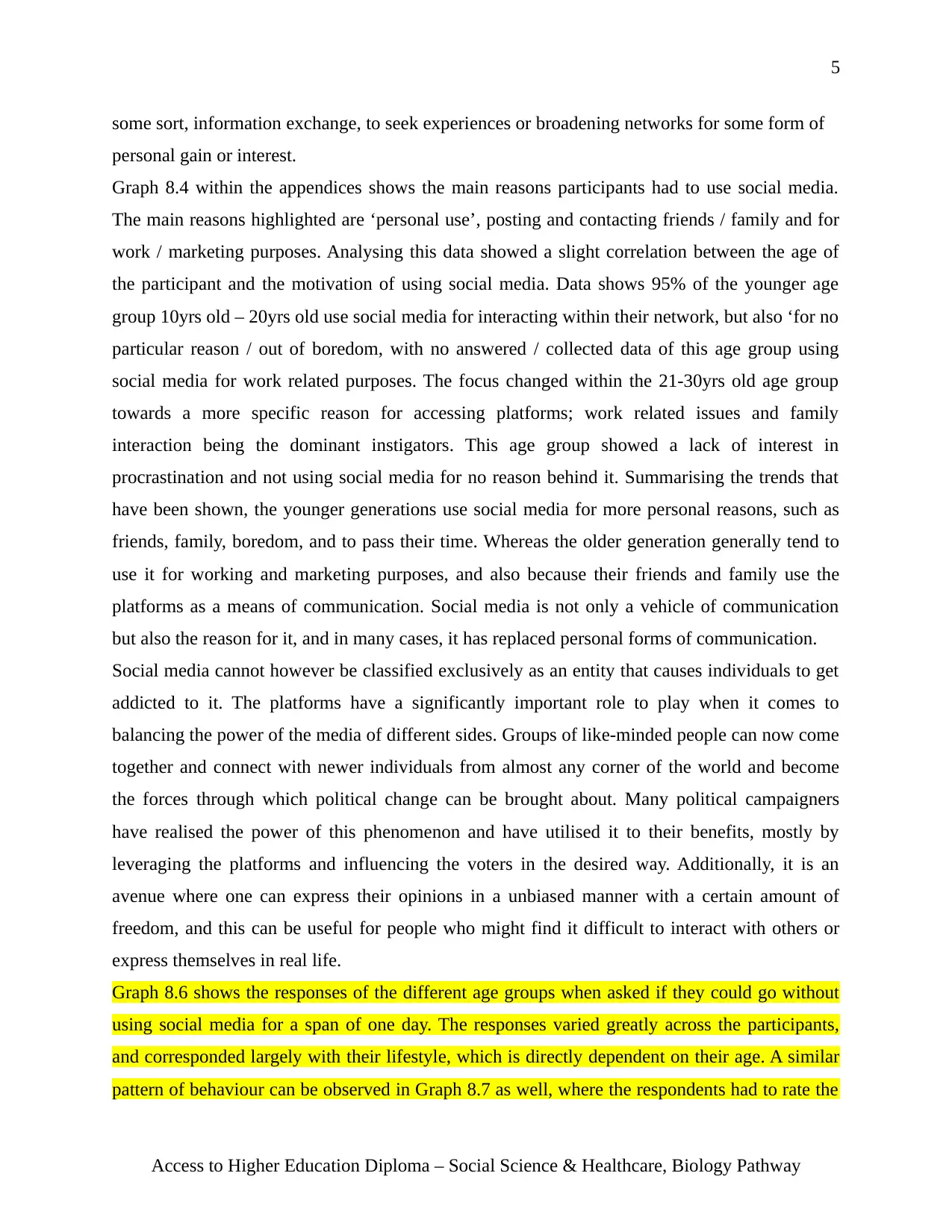
5
some sort, information exchange, to seek experiences or broadening networks for some form of
personal gain or interest.
Graph 8.4 within the appendices shows the main reasons participants had to use social media.
The main reasons highlighted are ‘personal use’, posting and contacting friends / family and for
work / marketing purposes. Analysing this data showed a slight correlation between the age of
the participant and the motivation of using social media. Data shows 95% of the younger age
group 10yrs old – 20yrs old use social media for interacting within their network, but also ‘for no
particular reason / out of boredom, with no answered / collected data of this age group using
social media for work related purposes. The focus changed within the 21-30yrs old age group
towards a more specific reason for accessing platforms; work related issues and family
interaction being the dominant instigators. This age group showed a lack of interest in
procrastination and not using social media for no reason behind it. Summarising the trends that
have been shown, the younger generations use social media for more personal reasons, such as
friends, family, boredom, and to pass their time. Whereas the older generation generally tend to
use it for working and marketing purposes, and also because their friends and family use the
platforms as a means of communication. Social media is not only a vehicle of communication
but also the reason for it, and in many cases, it has replaced personal forms of communication.
Social media cannot however be classified exclusively as an entity that causes individuals to get
addicted to it. The platforms have a significantly important role to play when it comes to
balancing the power of the media of different sides. Groups of like-minded people can now come
together and connect with newer individuals from almost any corner of the world and become
the forces through which political change can be brought about. Many political campaigners
have realised the power of this phenomenon and have utilised it to their benefits, mostly by
leveraging the platforms and influencing the voters in the desired way. Additionally, it is an
avenue where one can express their opinions in a unbiased manner with a certain amount of
freedom, and this can be useful for people who might find it difficult to interact with others or
express themselves in real life.
Graph 8.6 shows the responses of the different age groups when asked if they could go without
using social media for a span of one day. The responses varied greatly across the participants,
and corresponded largely with their lifestyle, which is directly dependent on their age. A similar
pattern of behaviour can be observed in Graph 8.7 as well, where the respondents had to rate the
Access to Higher Education Diploma – Social Science & Healthcare, Biology Pathway
some sort, information exchange, to seek experiences or broadening networks for some form of
personal gain or interest.
Graph 8.4 within the appendices shows the main reasons participants had to use social media.
The main reasons highlighted are ‘personal use’, posting and contacting friends / family and for
work / marketing purposes. Analysing this data showed a slight correlation between the age of
the participant and the motivation of using social media. Data shows 95% of the younger age
group 10yrs old – 20yrs old use social media for interacting within their network, but also ‘for no
particular reason / out of boredom, with no answered / collected data of this age group using
social media for work related purposes. The focus changed within the 21-30yrs old age group
towards a more specific reason for accessing platforms; work related issues and family
interaction being the dominant instigators. This age group showed a lack of interest in
procrastination and not using social media for no reason behind it. Summarising the trends that
have been shown, the younger generations use social media for more personal reasons, such as
friends, family, boredom, and to pass their time. Whereas the older generation generally tend to
use it for working and marketing purposes, and also because their friends and family use the
platforms as a means of communication. Social media is not only a vehicle of communication
but also the reason for it, and in many cases, it has replaced personal forms of communication.
Social media cannot however be classified exclusively as an entity that causes individuals to get
addicted to it. The platforms have a significantly important role to play when it comes to
balancing the power of the media of different sides. Groups of like-minded people can now come
together and connect with newer individuals from almost any corner of the world and become
the forces through which political change can be brought about. Many political campaigners
have realised the power of this phenomenon and have utilised it to their benefits, mostly by
leveraging the platforms and influencing the voters in the desired way. Additionally, it is an
avenue where one can express their opinions in a unbiased manner with a certain amount of
freedom, and this can be useful for people who might find it difficult to interact with others or
express themselves in real life.
Graph 8.6 shows the responses of the different age groups when asked if they could go without
using social media for a span of one day. The responses varied greatly across the participants,
and corresponded largely with their lifestyle, which is directly dependent on their age. A similar
pattern of behaviour can be observed in Graph 8.7 as well, where the respondents had to rate the
Access to Higher Education Diploma – Social Science & Healthcare, Biology Pathway
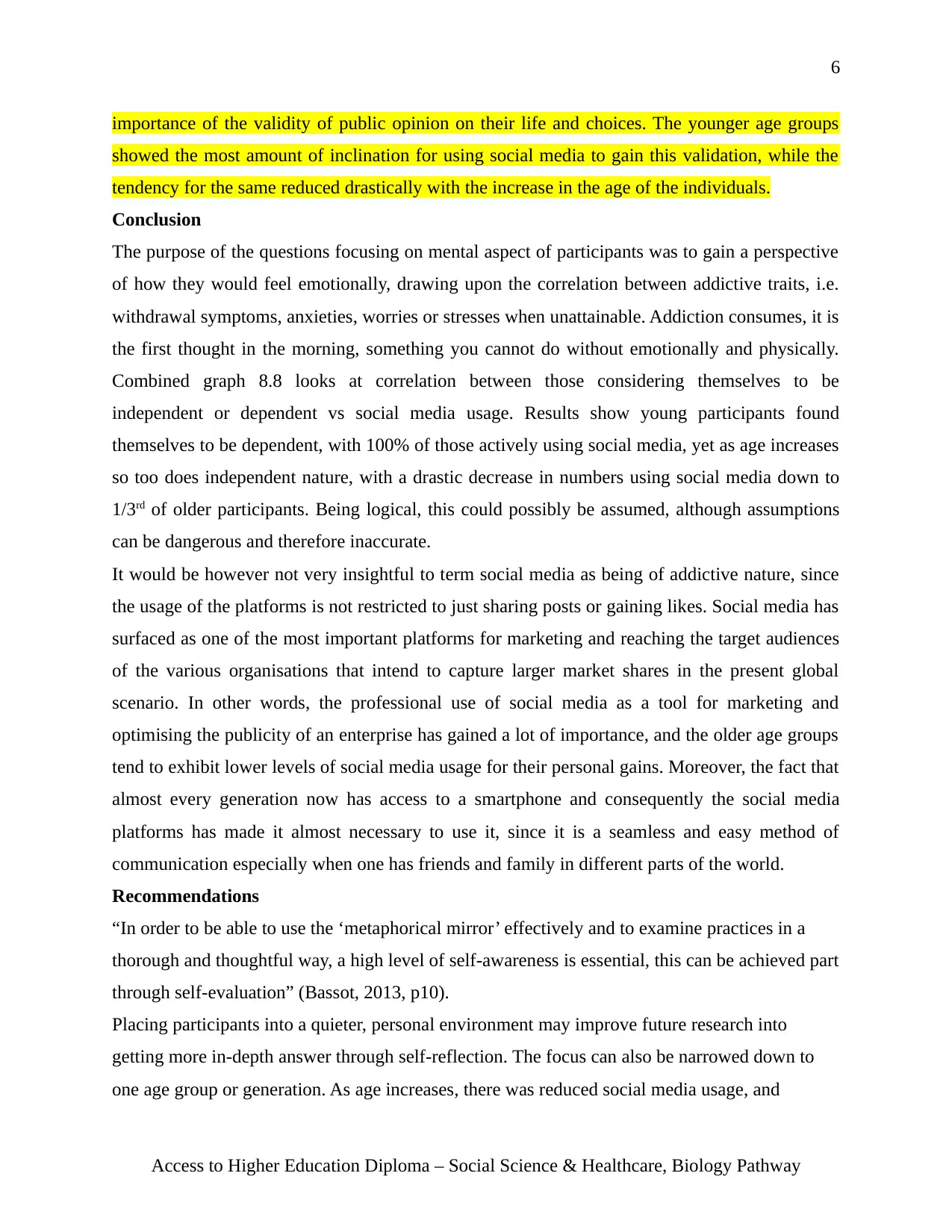
6
importance of the validity of public opinion on their life and choices. The younger age groups
showed the most amount of inclination for using social media to gain this validation, while the
tendency for the same reduced drastically with the increase in the age of the individuals.
Conclusion
The purpose of the questions focusing on mental aspect of participants was to gain a perspective
of how they would feel emotionally, drawing upon the correlation between addictive traits, i.e.
withdrawal symptoms, anxieties, worries or stresses when unattainable. Addiction consumes, it is
the first thought in the morning, something you cannot do without emotionally and physically.
Combined graph 8.8 looks at correlation between those considering themselves to be
independent or dependent vs social media usage. Results show young participants found
themselves to be dependent, with 100% of those actively using social media, yet as age increases
so too does independent nature, with a drastic decrease in numbers using social media down to
1/3rd of older participants. Being logical, this could possibly be assumed, although assumptions
can be dangerous and therefore inaccurate.
It would be however not very insightful to term social media as being of addictive nature, since
the usage of the platforms is not restricted to just sharing posts or gaining likes. Social media has
surfaced as one of the most important platforms for marketing and reaching the target audiences
of the various organisations that intend to capture larger market shares in the present global
scenario. In other words, the professional use of social media as a tool for marketing and
optimising the publicity of an enterprise has gained a lot of importance, and the older age groups
tend to exhibit lower levels of social media usage for their personal gains. Moreover, the fact that
almost every generation now has access to a smartphone and consequently the social media
platforms has made it almost necessary to use it, since it is a seamless and easy method of
communication especially when one has friends and family in different parts of the world.
Recommendations
“In order to be able to use the ‘metaphorical mirror’ effectively and to examine practices in a
thorough and thoughtful way, a high level of self-awareness is essential, this can be achieved part
through self-evaluation” (Bassot, 2013, p10).
Placing participants into a quieter, personal environment may improve future research into
getting more in-depth answer through self-reflection. The focus can also be narrowed down to
one age group or generation. As age increases, there was reduced social media usage, and
Access to Higher Education Diploma – Social Science & Healthcare, Biology Pathway
importance of the validity of public opinion on their life and choices. The younger age groups
showed the most amount of inclination for using social media to gain this validation, while the
tendency for the same reduced drastically with the increase in the age of the individuals.
Conclusion
The purpose of the questions focusing on mental aspect of participants was to gain a perspective
of how they would feel emotionally, drawing upon the correlation between addictive traits, i.e.
withdrawal symptoms, anxieties, worries or stresses when unattainable. Addiction consumes, it is
the first thought in the morning, something you cannot do without emotionally and physically.
Combined graph 8.8 looks at correlation between those considering themselves to be
independent or dependent vs social media usage. Results show young participants found
themselves to be dependent, with 100% of those actively using social media, yet as age increases
so too does independent nature, with a drastic decrease in numbers using social media down to
1/3rd of older participants. Being logical, this could possibly be assumed, although assumptions
can be dangerous and therefore inaccurate.
It would be however not very insightful to term social media as being of addictive nature, since
the usage of the platforms is not restricted to just sharing posts or gaining likes. Social media has
surfaced as one of the most important platforms for marketing and reaching the target audiences
of the various organisations that intend to capture larger market shares in the present global
scenario. In other words, the professional use of social media as a tool for marketing and
optimising the publicity of an enterprise has gained a lot of importance, and the older age groups
tend to exhibit lower levels of social media usage for their personal gains. Moreover, the fact that
almost every generation now has access to a smartphone and consequently the social media
platforms has made it almost necessary to use it, since it is a seamless and easy method of
communication especially when one has friends and family in different parts of the world.
Recommendations
“In order to be able to use the ‘metaphorical mirror’ effectively and to examine practices in a
thorough and thoughtful way, a high level of self-awareness is essential, this can be achieved part
through self-evaluation” (Bassot, 2013, p10).
Placing participants into a quieter, personal environment may improve future research into
getting more in-depth answer through self-reflection. The focus can also be narrowed down to
one age group or generation. As age increases, there was reduced social media usage, and
Access to Higher Education Diploma – Social Science & Healthcare, Biology Pathway
⊘ This is a preview!⊘
Do you want full access?
Subscribe today to unlock all pages.

Trusted by 1+ million students worldwide
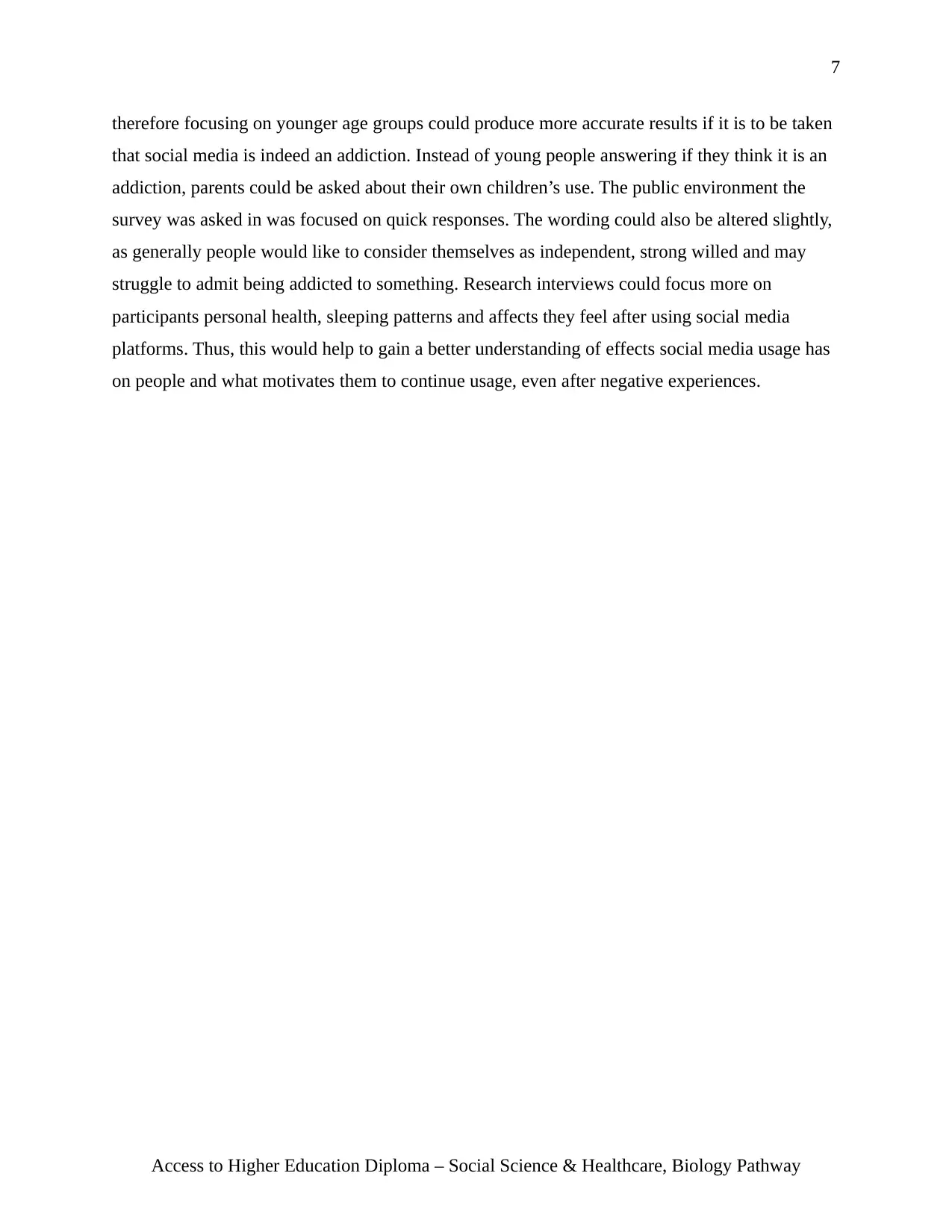
7
therefore focusing on younger age groups could produce more accurate results if it is to be taken
that social media is indeed an addiction. Instead of young people answering if they think it is an
addiction, parents could be asked about their own children’s use. The public environment the
survey was asked in was focused on quick responses. The wording could also be altered slightly,
as generally people would like to consider themselves as independent, strong willed and may
struggle to admit being addicted to something. Research interviews could focus more on
participants personal health, sleeping patterns and affects they feel after using social media
platforms. Thus, this would help to gain a better understanding of effects social media usage has
on people and what motivates them to continue usage, even after negative experiences.
Access to Higher Education Diploma – Social Science & Healthcare, Biology Pathway
therefore focusing on younger age groups could produce more accurate results if it is to be taken
that social media is indeed an addiction. Instead of young people answering if they think it is an
addiction, parents could be asked about their own children’s use. The public environment the
survey was asked in was focused on quick responses. The wording could also be altered slightly,
as generally people would like to consider themselves as independent, strong willed and may
struggle to admit being addicted to something. Research interviews could focus more on
participants personal health, sleeping patterns and affects they feel after using social media
platforms. Thus, this would help to gain a better understanding of effects social media usage has
on people and what motivates them to continue usage, even after negative experiences.
Access to Higher Education Diploma – Social Science & Healthcare, Biology Pathway
Paraphrase This Document
Need a fresh take? Get an instant paraphrase of this document with our AI Paraphraser
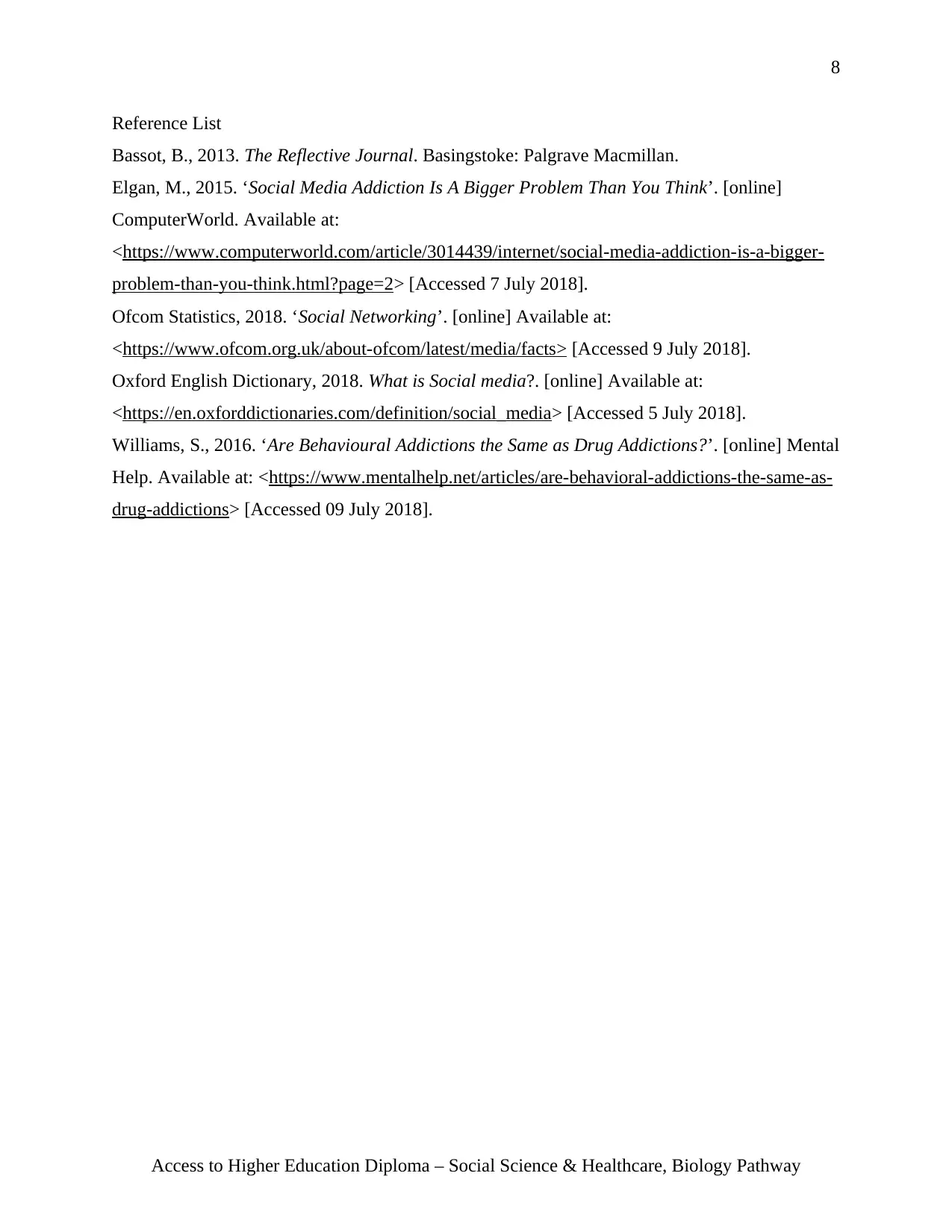
8
Reference List
Bassot, B., 2013. The Reflective Journal. Basingstoke: Palgrave Macmillan.
Elgan, M., 2015. ‘Social Media Addiction Is A Bigger Problem Than You Think’. [online]
ComputerWorld. Available at:
<https://www.computerworld.com/article/3014439/internet/social-media-addiction-is-a-bigger-
problem-than-you-think.html?page=2> [Accessed 7 July 2018].
Ofcom Statistics, 2018. ‘Social Networking’. [online] Available at:
<https://www.ofcom.org.uk/about-ofcom/latest/media/facts> [Accessed 9 July 2018].
Oxford English Dictionary, 2018. What is Social media?. [online] Available at:
<https://en.oxforddictionaries.com/definition/social_media> [Accessed 5 July 2018].
Williams, S., 2016. ‘Are Behavioural Addictions the Same as Drug Addictions?’. [online] Mental
Help. Available at: <https://www.mentalhelp.net/articles/are-behavioral-addictions-the-same-as-
drug-addictions> [Accessed 09 July 2018].
Access to Higher Education Diploma – Social Science & Healthcare, Biology Pathway
Reference List
Bassot, B., 2013. The Reflective Journal. Basingstoke: Palgrave Macmillan.
Elgan, M., 2015. ‘Social Media Addiction Is A Bigger Problem Than You Think’. [online]
ComputerWorld. Available at:
<https://www.computerworld.com/article/3014439/internet/social-media-addiction-is-a-bigger-
problem-than-you-think.html?page=2> [Accessed 7 July 2018].
Ofcom Statistics, 2018. ‘Social Networking’. [online] Available at:
<https://www.ofcom.org.uk/about-ofcom/latest/media/facts> [Accessed 9 July 2018].
Oxford English Dictionary, 2018. What is Social media?. [online] Available at:
<https://en.oxforddictionaries.com/definition/social_media> [Accessed 5 July 2018].
Williams, S., 2016. ‘Are Behavioural Addictions the Same as Drug Addictions?’. [online] Mental
Help. Available at: <https://www.mentalhelp.net/articles/are-behavioral-addictions-the-same-as-
drug-addictions> [Accessed 09 July 2018].
Access to Higher Education Diploma – Social Science & Healthcare, Biology Pathway
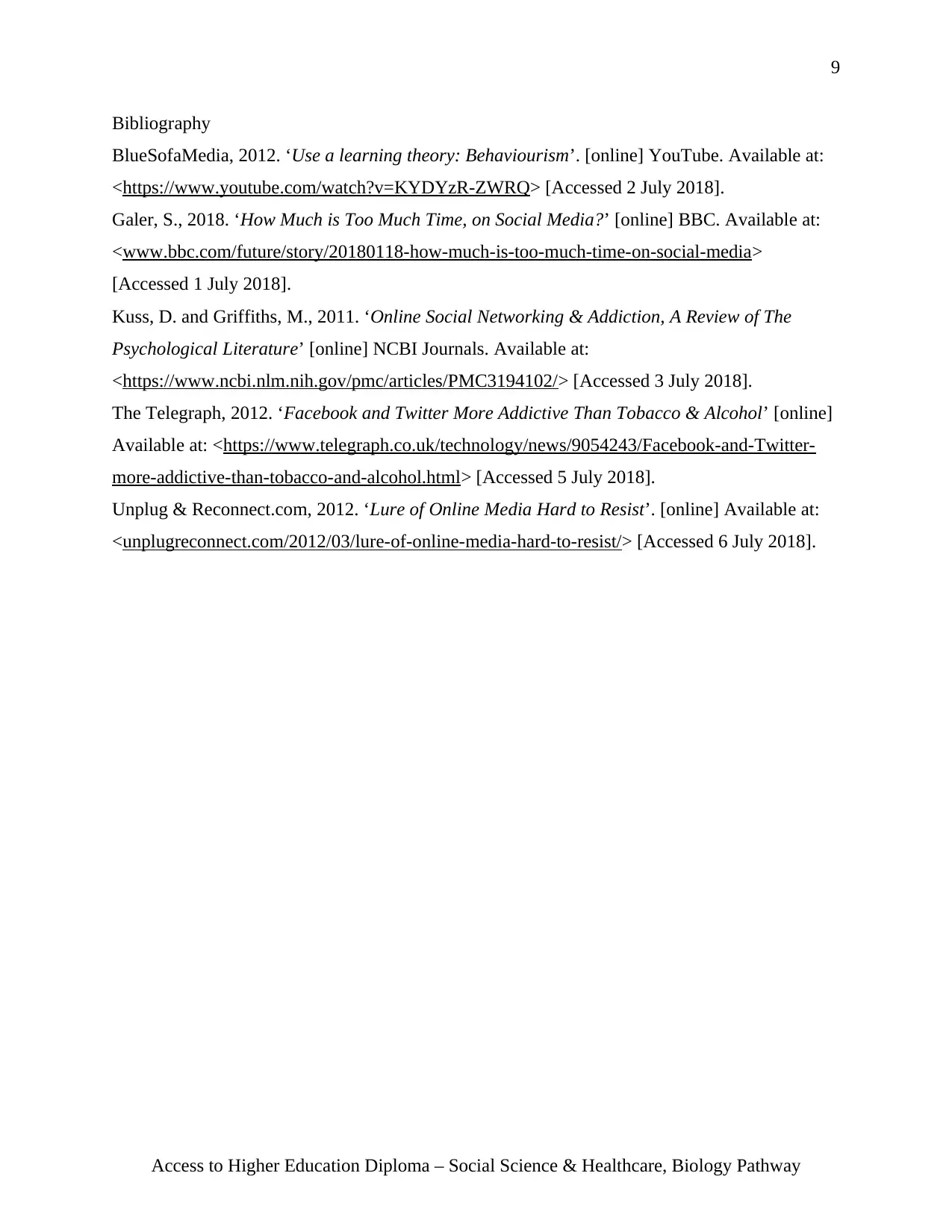
9
Bibliography
BlueSofaMedia, 2012. ‘Use a learning theory: Behaviourism’. [online] YouTube. Available at:
<https://www.youtube.com/watch?v=KYDYzR-ZWRQ> [Accessed 2 July 2018].
Galer, S., 2018. ‘How Much is Too Much Time, on Social Media?’ [online] BBC. Available at:
<www.bbc.com/future/story/20180118-how-much-is-too-much-time-on-social-media>
[Accessed 1 July 2018].
Kuss, D. and Griffiths, M., 2011. ‘Online Social Networking & Addiction, A Review of The
Psychological Literature’ [online] NCBI Journals. Available at:
<https://www.ncbi.nlm.nih.gov/pmc/articles/PMC3194102/> [Accessed 3 July 2018].
The Telegraph, 2012. ‘Facebook and Twitter More Addictive Than Tobacco & Alcohol’ [online]
Available at: <https://www.telegraph.co.uk/technology/news/9054243/Facebook-and-Twitter-
more-addictive-than-tobacco-and-alcohol.html> [Accessed 5 July 2018].
Unplug & Reconnect.com, 2012. ‘Lure of Online Media Hard to Resist’. [online] Available at:
<unplugreconnect.com/2012/03/lure-of-online-media-hard-to-resist/> [Accessed 6 July 2018].
Access to Higher Education Diploma – Social Science & Healthcare, Biology Pathway
Bibliography
BlueSofaMedia, 2012. ‘Use a learning theory: Behaviourism’. [online] YouTube. Available at:
<https://www.youtube.com/watch?v=KYDYzR-ZWRQ> [Accessed 2 July 2018].
Galer, S., 2018. ‘How Much is Too Much Time, on Social Media?’ [online] BBC. Available at:
<www.bbc.com/future/story/20180118-how-much-is-too-much-time-on-social-media>
[Accessed 1 July 2018].
Kuss, D. and Griffiths, M., 2011. ‘Online Social Networking & Addiction, A Review of The
Psychological Literature’ [online] NCBI Journals. Available at:
<https://www.ncbi.nlm.nih.gov/pmc/articles/PMC3194102/> [Accessed 3 July 2018].
The Telegraph, 2012. ‘Facebook and Twitter More Addictive Than Tobacco & Alcohol’ [online]
Available at: <https://www.telegraph.co.uk/technology/news/9054243/Facebook-and-Twitter-
more-addictive-than-tobacco-and-alcohol.html> [Accessed 5 July 2018].
Unplug & Reconnect.com, 2012. ‘Lure of Online Media Hard to Resist’. [online] Available at:
<unplugreconnect.com/2012/03/lure-of-online-media-hard-to-resist/> [Accessed 6 July 2018].
Access to Higher Education Diploma – Social Science & Healthcare, Biology Pathway
⊘ This is a preview!⊘
Do you want full access?
Subscribe today to unlock all pages.

Trusted by 1+ million students worldwide
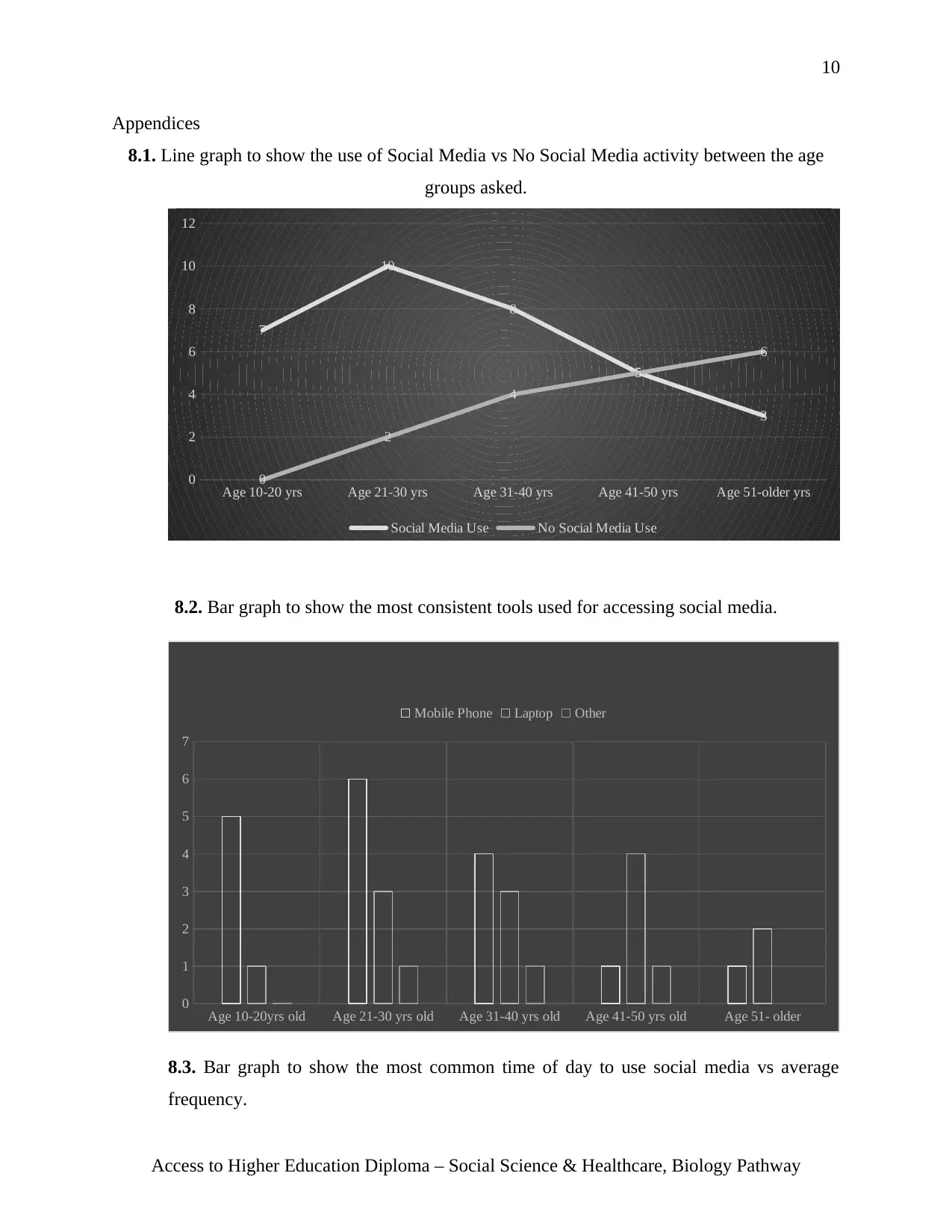
10
Appendices
8.1. Line graph to show the use of Social Media vs No Social Media activity between the age
groups asked.
Age 10-20 yrs Age 21-30 yrs Age 31-40 yrs Age 41-50 yrs Age 51-older yrs
0
2
4
6
8
10
12
7
10
8
5
3
0
2
4
5
6
Social Media Use No Social Media Use
8.2. Bar graph to show the most consistent tools used for accessing social media.
Age 10-20yrs old Age 21-30 yrs old Age 31-40 yrs old Age 41-50 yrs old Age 51- older
0
1
2
3
4
5
6
7
Mobile Phone Laptop Other
8.3. Bar graph to show the most common time of day to use social media vs average
frequency.
Access to Higher Education Diploma – Social Science & Healthcare, Biology Pathway
Appendices
8.1. Line graph to show the use of Social Media vs No Social Media activity between the age
groups asked.
Age 10-20 yrs Age 21-30 yrs Age 31-40 yrs Age 41-50 yrs Age 51-older yrs
0
2
4
6
8
10
12
7
10
8
5
3
0
2
4
5
6
Social Media Use No Social Media Use
8.2. Bar graph to show the most consistent tools used for accessing social media.
Age 10-20yrs old Age 21-30 yrs old Age 31-40 yrs old Age 41-50 yrs old Age 51- older
0
1
2
3
4
5
6
7
Mobile Phone Laptop Other
8.3. Bar graph to show the most common time of day to use social media vs average
frequency.
Access to Higher Education Diploma – Social Science & Healthcare, Biology Pathway
Paraphrase This Document
Need a fresh take? Get an instant paraphrase of this document with our AI Paraphraser
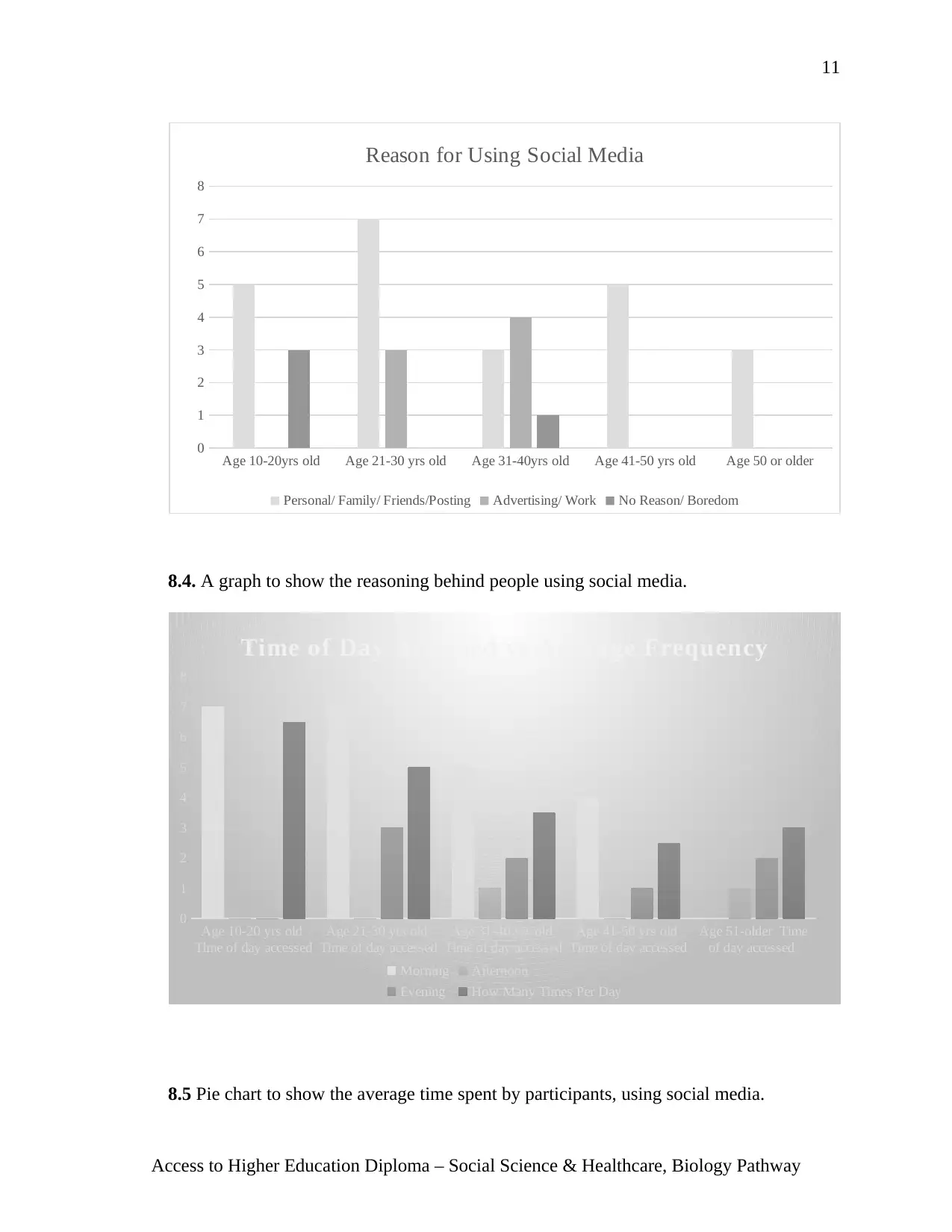
11
8.4. A graph to show the reasoning behind people using social media.
8.5 Pie chart to show the average time spent by participants, using social media.
Access to Higher Education Diploma – Social Science & Healthcare, Biology Pathway
Age 10-20yrs old Age 21-30 yrs old Age 31-40yrs old Age 41-50 yrs old Age 50 or older
0
1
2
3
4
5
6
7
8
Reason for Using Social Media
Personal/ Family/ Friends/Posting Advertising/ Work No Reason/ Boredom
Age 10-20 yrs old
Time of day accessed
Age 21-30 yrs old
Time of day accessed
Age 31-40 yrs old
Time of day accessed
Age 41-50 yrs old
Time of day accessed
Age 51-older Time
of day accessed
0
1
2
3
4
5
6
7
8
Time of Day Accessed vs Average Frequency
Morning Afternoon
Evening How Many Times Per Day
8.4. A graph to show the reasoning behind people using social media.
8.5 Pie chart to show the average time spent by participants, using social media.
Access to Higher Education Diploma – Social Science & Healthcare, Biology Pathway
Age 10-20yrs old Age 21-30 yrs old Age 31-40yrs old Age 41-50 yrs old Age 50 or older
0
1
2
3
4
5
6
7
8
Reason for Using Social Media
Personal/ Family/ Friends/Posting Advertising/ Work No Reason/ Boredom
Age 10-20 yrs old
Time of day accessed
Age 21-30 yrs old
Time of day accessed
Age 31-40 yrs old
Time of day accessed
Age 41-50 yrs old
Time of day accessed
Age 51-older Time
of day accessed
0
1
2
3
4
5
6
7
8
Time of Day Accessed vs Average Frequency
Morning Afternoon
Evening How Many Times Per Day
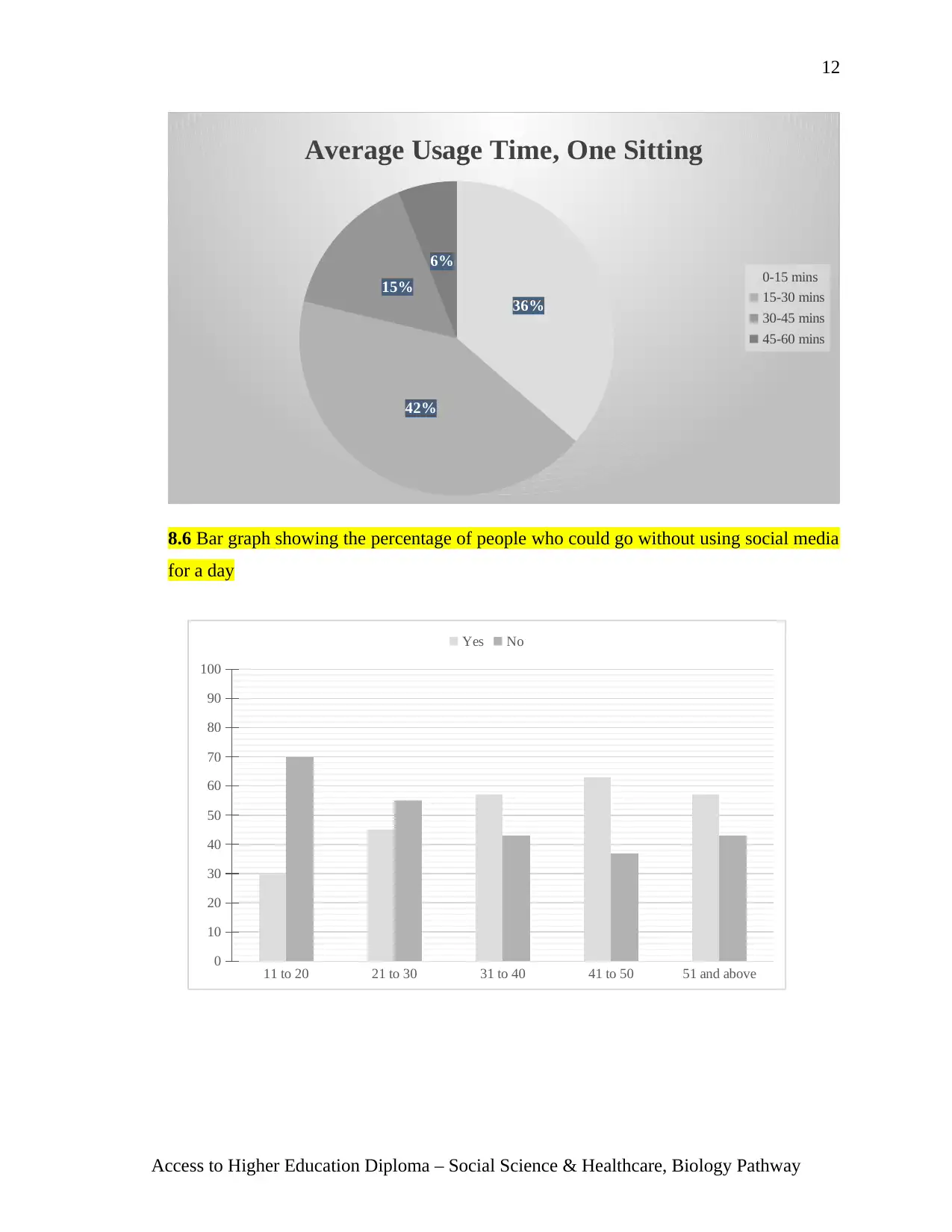
12
36%
42%
15%
6%
Average Usage Time, One Sitting
0-15 mins
15-30 mins
30-45 mins
45-60 mins
8.6 Bar graph showing the percentage of people who could go without using social media
for a day
Access to Higher Education Diploma – Social Science & Healthcare, Biology Pathway
11 to 20 21 to 30 31 to 40 41 to 50 51 and above
0
10
20
30
40
50
60
70
80
90
100
Yes No
36%
42%
15%
6%
Average Usage Time, One Sitting
0-15 mins
15-30 mins
30-45 mins
45-60 mins
8.6 Bar graph showing the percentage of people who could go without using social media
for a day
Access to Higher Education Diploma – Social Science & Healthcare, Biology Pathway
11 to 20 21 to 30 31 to 40 41 to 50 51 and above
0
10
20
30
40
50
60
70
80
90
100
Yes No
⊘ This is a preview!⊘
Do you want full access?
Subscribe today to unlock all pages.

Trusted by 1+ million students worldwide
1 out of 15
Related Documents
Your All-in-One AI-Powered Toolkit for Academic Success.
+13062052269
info@desklib.com
Available 24*7 on WhatsApp / Email
![[object Object]](/_next/static/media/star-bottom.7253800d.svg)
Unlock your academic potential
Copyright © 2020–2025 A2Z Services. All Rights Reserved. Developed and managed by ZUCOL.




